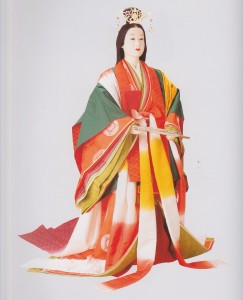きものDo!ニュース
2015年01月07日
平安朝 公家女房物具装束姿
「日本時代衣裳展覧室」でもあまり展示されることのない
「公家女房物具装束姿(くげにょうぼうもののぐしょうぞくすがた)」
をご紹介いたします。
垂髪(下げ髪)を両鬢と後頭部の三つに分け
後頭部は両鬢より少し長くして、下部を輪状に肩のあたりより取り上げ
頭頂部にて毛先部で結髪。 宝冠を髷の前部につけています。
構成・着装は
長袴をつけた上に
五つ重ねの衣(後の五衣)・打衣・菊花丸文の表着を一ツ襟に着装して、
裳をつけた後に、裙帯を前で結び垂れ、唐衣を着放ち
その上に領巾を屏風襞を背から肩にかけて
畳みショールのようにつけ長く垂らし、帖紙を懐中し檜扇を手にしています。
この姿は「紫式部日記」(1010年頃)に“…その日の髪あげうるはしきすがた、
唐絵ををかしげにかきたるやうなり。
青色の唐衣、裾濃の裳。領巾、裙帯は浮線綾を櫨淡に染めたり。
表着は菊の五重。搔練は紅。すがたつき、もてなし…”
の条が見えますが、これより、考証・復元
「年中行事絵巻」(1165年頃)の第五巻第五段に見える舞姫の姿を参考に
髪型・化粧を考案し着装したものです。
「十二単」「十二単衣」「十二一重」などど書かれ
“じゅうにひとえ”と訓まれますが民間の俗称です。
現在、宮中で御着用の「五衣・唐衣・裳の御服」(俗に十二単)は
第二位の「朝服」に相当するものとして
平安時代の中頃(970年頃)誕生し着用され
その姿は「直衣姿」と呼ばれました。
そして、第一位の「礼服」に当たるのが「物具姿」です。
「物具姿」の解釈にもいくつか考えられますが
ここでは、平安末期に廃止となった
幻の十二単とも言える「裙帯、領巾の物具装束姿」としています。
Noble woman in mononogu costume of the Heian period.
The hair is devided into three parts: sides and the back.
The hair in the back, longer than on the sides,
is put up at the shoulder level and done in a chignon on the head.
A crown is worn in front of the chignon.
How to wear:
First, a long hakama pleated skirt is put on,
followed by five-layered undergarments (later called itsutsuginu),
an uchiginu upper garment and a round-chrysanthemum-patterned
over garment with eri neckbands layered in one.
Then a mo long pleated skirt is put on, a kutai
band is tired in the front to hang down, a karaginu is kept loose,
and on it a hire scarf the same as the kutai,
is hung long around the neck like a folded shawl.
To finish up, tatoh paper under the upper neckband
and a fan in the right hand.
The “Dairy of Murasaki Shikibu” (about 1010) has passages:
“Ladies-in-waiting appeared. Their hair is done nicely.
They are as beautiful as seen in Chinese painting.
Their karaginu are blue, their mo are dark in color at the buttom.
Their hire and kutai are made of aya silk dyed in light orange.
Their red outer garments are of five-petaled chrysanthemum pattern
with kaineri layers in red. They look elegant and pure.
“Based on this description and with reference to the dancer in Column 5,
Volume 5 of the “Picture Scroll of Annual Events.”(about 1165)
the costume, hair style and make-up in the picture were designed.
There is another type of costume called junihitoe,
literally meaning twelve layers.
The costume commonly called junihitoe consisting of
itsutsuginu, karaginu, and mo,
which is worn in the imperial court at present,
started in the middle of the Heian period (about 970)
as the second-rank chohfuku court-attending costume,
while mononogu was equivalent to
the first-rank raifuku ceremonial costume.
The interpretation of mononogu varies,
but here mononogu with a kutai and a hire,
which were abolished at the end of the Heian period,
is regarded as mononogu.
平成27年1月18日(日)
着装道宮島流衣紋による着装をご覧いただきます。
お楽しみに!



